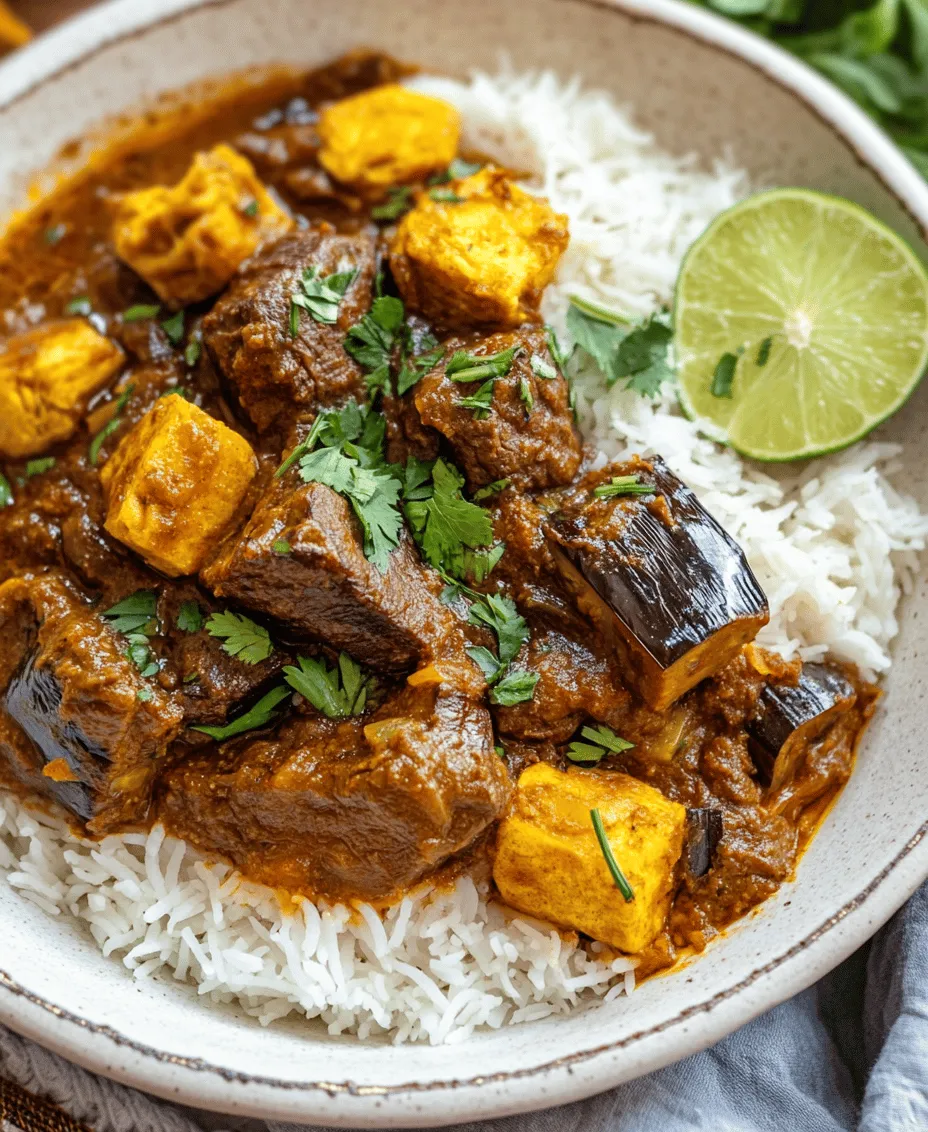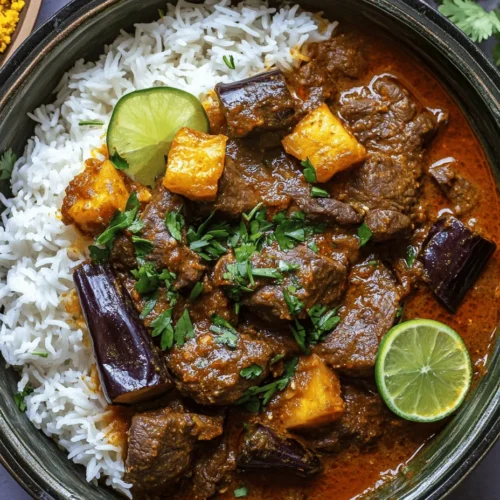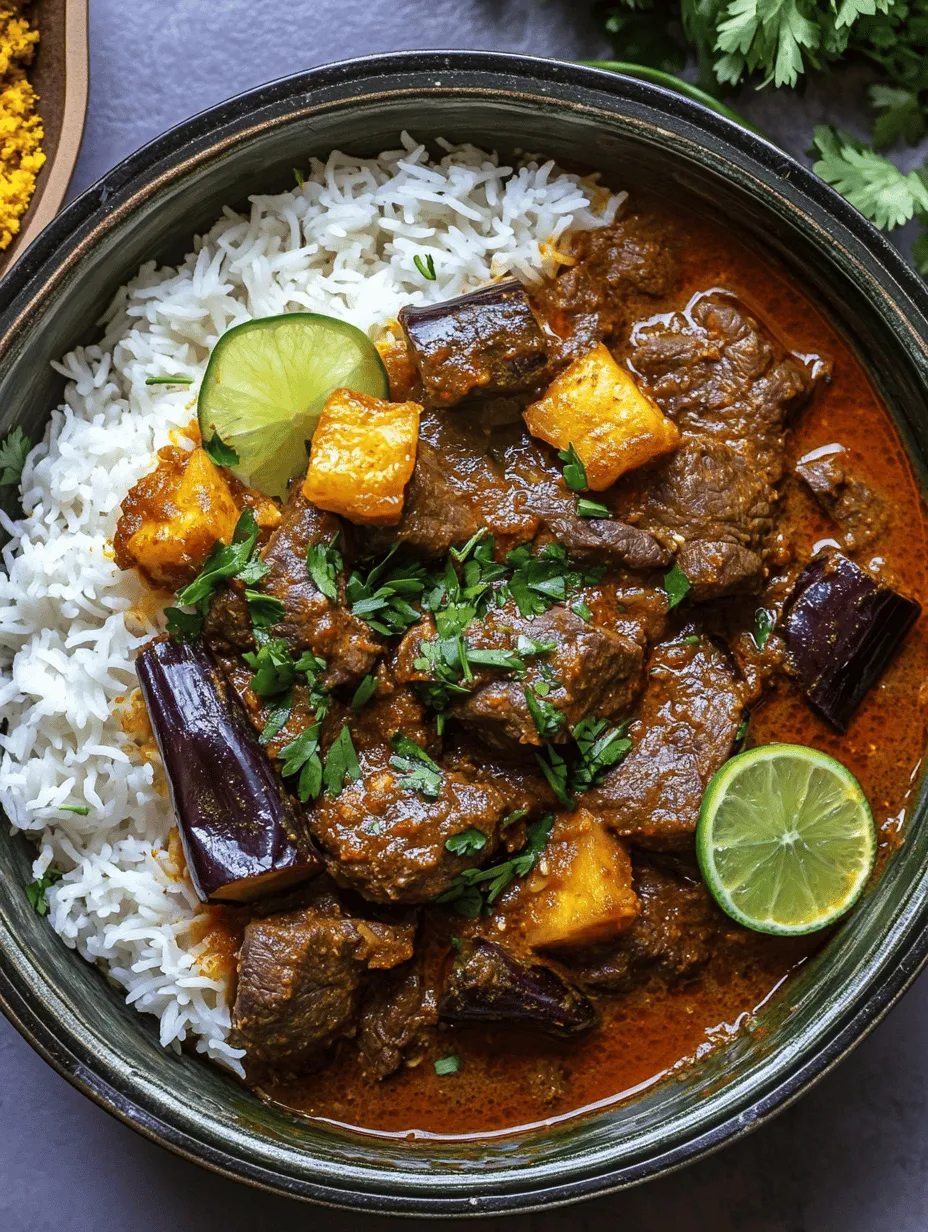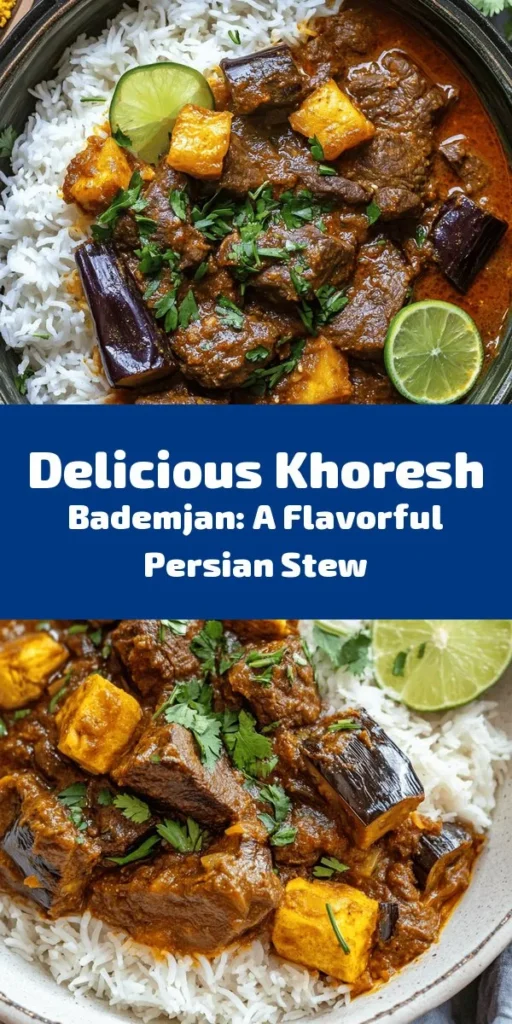Introduction
In the realm of Persian cuisine, Khoresh Bademjan stands out as a beloved dish that combines rich flavors with wholesome ingredients. This savory eggplant stew, typically made with tender meat and aromatic spices, is perfect for family gatherings or cozy dinners. Originating from the heart of Iran, Khoresh Bademjan is not just a meal; it embodies a tradition that celebrates the art of cooking and the joy of sharing food with loved ones. In this article, we will delve into the origins of Khoresh Bademjan, its cultural significance, and provide a comprehensive guide to preparing this delectable dish at home.
Understanding Khoresh Bademjan
Exploring the Historical Significance of Khoresh Bademjan
Stews have played an integral role in Persian cuisine for centuries, serving as a hearty and nourishing staple that warms both the body and soul. Khoresh Bademjan, which translates to “eggplant stew,” showcases the Persian commitment to using fresh, seasonal ingredients that reflect the agricultural bounty of the region. While the precise origins of Khoresh Bademjan remain somewhat obscure, it is widely believed that this dish has evolved through generations, influenced by the flavors and techniques of various regions within Iran.
Cultural celebrations often feature Khoresh Bademjan, symbolizing hospitality and the gathering of family and friends. It is a dish that transcends everyday meals, gracing the table during special occasions, family reunions, and holidays. Its multilayered flavors and comforting nature make it a favorite among many Iranians, and it is often accompanied by fragrant basmati rice, enhancing its sumptuousness.
Regional variations of Khoresh Bademjan exist, with differences in ingredients and preparation methods reflecting local tastes and available produce. In some areas, for instance, cooks may include additional vegetables or adjust the balance of spices to suit their preferences. Meanwhile, personal adaptations have led to the incorporation of vegetarian or vegan versions, allowing this beloved dish to cater to a variety of dietary choices while preserving its essence.
Delving Into the Ingredients
Khoresh Bademjan’s rich flavor profile is achieved through a careful selection of ingredients, each contributing to the overall taste and texture of the dish. At the heart of this stew lies the humble eggplant, a vegetable cherished in Persian cooking. Eggplants are not only versatile but also absorb flavors beautifully, making them an ideal base for the savory sauce that characterizes Khoresh Bademjan. When selecting eggplants for this recipe, look for firm, glossy specimens with smooth skin, as they tend to have fewer seeds and a better overall texture.
Choosing the right meat is another crucial aspect of preparing Khoresh Bademjan. Traditionally, beef or lamb is used, with both options offering distinct flavors and textures. Beef, particularly stewing cuts like chuck or brisket, provides a hearty base for the stew, while lamb adds a unique richness. Regardless of your choice, ensure the meat is fresh, as its quality will significantly influence the final dish.
The role of spices in Khoresh Bademjan cannot be overstated. A blend of turmeric, cinnamon, and saffron creates a warm and aromatic foundation that enhances the stew’s flavor. Turmeric, known for its vibrant color and health benefits, adds a subtle earthiness, while cinnamon offers a hint of sweetness that balances the dish. Saffron, often considered the crown jewel of spices, lends a luxurious aroma and a distinctive golden hue to the stew. When used judiciously, these spices elevate the dish from ordinary to extraordinary.
Fresh herbs also play a vital role in Khoresh Bademjan, contributing brightness and depth to the stew. Parsley, cilantro, and mint are commonly used, each herb bringing its unique character to the dish. Fresh herbs should be added towards the end of cooking to retain their vibrant flavors and colors, creating a lovely contrast with the cooked ingredients.
Preparation Steps for Khoresh Bademjan
Preparing the Eggplants
The first step in creating a delicious Khoresh Bademjan is preparing the eggplants. This process begins with salting the eggplants, a crucial technique that helps remove excess moisture and bitterness. By sprinkling salt over sliced eggplants and allowing them to sit for about 30 minutes, you allow the salt to draw out the water. This step not only enhances the flavor of the eggplants but also ensures they have a firmer texture when cooked, preventing them from becoming mushy in the stew.
After salting, rinse the eggplants thoroughly under cold water to remove the salt and any bitterness that has been drawn out. Pat them dry with a clean kitchen towel or paper towels to absorb excess moisture. This drying process is essential, as it prepares the eggplants for frying or sautéing, which will further enhance their flavor and texture.
When it comes to cooking the eggplants, there are a few techniques to choose from. Some home cooks prefer to fry the eggplant slices until golden brown, while others may opt for baking or grilling to achieve a healthier version. Regardless of the method you choose, aim for a slightly crispy exterior and a tender, creamy interior. This will ensure that the eggplants hold their shape and contribute a satisfying bite to the finished stew.
Cooking the Meat
With the eggplants prepared, it’s time to turn your attention to the meat. Begin by sautéing finely chopped onions and minced garlic in a heavy pot or Dutch oven. This step is crucial for building depth of flavor in your Khoresh Bademjan. Allow the onions to cook until they become translucent and fragrant, which usually takes about 5 to 7 minutes. Adding minced garlic towards the end of this step prevents it from burning and becoming bitter, ensuring a balanced flavor profile.
Once the onions and garlic are ready, it’s time to brown the meat. Add your choice of beef or lamb to the pot, ensuring that each piece is well-coated in the flavorful onion mixture. The goal here is to achieve a nice sear on the meat, which not only enhances its flavor but also locks in moisture. Searing the meat should take about 8 to 10 minutes, during which you’ll want to turn the pieces occasionally to ensure even browning.
Layering the Flavors
As the meat browns, it’s time to incorporate the carefully selected spices that will define the character of Khoresh Bademjan. Add turmeric and cinnamon at this stage, stirring them into the meat and onion mixture. This allows the spices to toast slightly, releasing their essential oils and intensifying their flavors. After a minute, add the saffron, which should be steeped in a tablespoon of hot water to maximize its flavor and color. Stir this mixture well, ensuring that the spices coat the meat evenly.
Once the spices are fragrant and well combined, it’s time to add the prepared eggplants to the pot. Gently fold them into the meat and spice mixture, allowing each slice of eggplant to absorb the flavors of the stew. After this, pour in enough water or broth to cover the ingredients. This liquid will create a rich and savory sauce as the stew simmers. Bring the mixture to a gentle boil, then reduce the heat to low and cover the pot. Simmering the Khoresh Bademjan for at least one to two hours will allow the flavors to meld beautifully and the meat to become tender.
By following these initial steps carefully, you will be well on your way to creating a memorable Khoresh Bademjan that not only satisfies the palate but also embodies the warmth and hospitality of Persian culinary traditions. As you prepare this dish, remember that patience is key; allowing the stew to simmer and develop its flavors will reward you with an authentic and delicious experience.

The Significance of Adding Tomatoes and Moisture
When preparing Khoresh Bademjan, the inclusion of tomatoes serves a dual purpose: it adds essential moisture to the dish while also contributing a depth of flavor that is pivotal to the overall profile of the stew. Tomatoes, when cooked down, release their natural sugars and acidity, which balance the richness of the meat and the earthiness of the eggplants.
In many traditional recipes, fresh tomatoes are preferred for their vibrant taste, but canned tomatoes can also be used for convenience. The key is to ensure that they are of high quality—look for tomatoes packed in juice rather than syrup, as this will keep the flavors bright and fresh. Additionally, the moisture from the tomatoes helps in creating a luscious sauce that clings to the meat and vegetables, ensuring that every bite is infused with flavor.
Simmering the Stew
Understanding the Importance of Low and Slow Cooking
One of the most critical steps in cooking Khoresh Bademjan is the simmering process. Low and slow cooking allows the flavors to meld together beautifully, creating a harmonious stew that tantalizes the taste buds. This method of cooking enables the tougher cuts of meat to break down, becoming tender and juicy, while the vegetables soften and absorb the rich flavors of the sauce.
Typically, Khoresh Bademjan is simmered for at least 1.5 to 2 hours, depending on the cut of meat used. This slow cooking process not only enhances the flavor but also ensures that the meat becomes fork-tender. The key is to maintain a gentle simmer; boiling can cause the meat to toughen and the vegetables to disintegrate.
How to Determine the Ideal Cooking Time for Tenderness
To achieve the perfect texture, it’s essential to check the meat periodically throughout the cooking process. A good rule of thumb is to start checking for tenderness after the first hour of simmering. Use a fork to poke the meat; it should yield easily without any resistance.
Additionally, keep an eye on the sauce’s consistency. If it becomes too thick before the meat is tender, you can add a splash of water or broth to maintain the desired moisture level. Remember, the goal is to create a stew that is rich and flavorful, not dry or overly thick.
Adding the Eggplants and Final Touches
Timing for Adding Eggplants to Ensure They Retain Their Texture
Eggplants are a star ingredient in Khoresh Bademjan, and adding them at the right time is crucial for achieving the perfect texture. Ideally, you should add the sautéed eggplants to the stew about 30 to 40 minutes before the cooking time is up. This timing allows the eggplants to absorb the flavors of the stew while maintaining their shape and texture.
If added too early, the eggplants may become mushy and lose their distinct character. Conversely, adding them too late will result in undercooked eggplants that don’t meld well with the rest of the dish. Carefully monitor the cooking time to ensure that the eggplants are perfectly tender yet still hold their form.
The Art of Seasoning and Adjusting Flavors
Seasoning is an art form, and it’s essential to taste and adjust the flavors as you go. After adding the eggplants, give the stew a good stir and taste for seasoning. Depending on your preference, you may want to add more salt, pepper, or even a pinch of sugar to balance the acidity of the tomatoes.
A squeeze of fresh lemon juice or a sprinkle of sumac can also elevate the dish by adding a bright, zesty note that cuts through the richness. Remember that flavors develop as the stew cooks, so don’t hesitate to make adjustments in the final stages of cooking.
Serving Khoresh Bademjan
Presentation Ideas for a Stunning Dish
Presentation plays a significant role in how we enjoy our meals, and Khoresh Bademjan is no exception. When serving this dish, consider using a large, shallow bowl to showcase the vibrant colors of the stew. The rich, reddish-brown sauce, coupled with the golden-brown eggplants, creates an inviting visual appeal.
A traditional Persian serving method involves placing the Khoresh Bademjan on a bed of saffron-infused basmati rice, allowing the sauce to soak into the grains. This not only enhances the dish visually but also makes for a fulfilling meal.
Garnishes That Enhance Both Flavor and Visual Appeal
To elevate the presentation and flavor profile of Khoresh Bademjan, consider garnishing it with freshly chopped herbs such as parsley or cilantro. These herbs not only add a pop of green to the dish but also provide a fresh, aromatic quality that complements the rich stew.
You can also sprinkle some toasted slivered almonds or walnuts on top for a delightful crunch, or add a few slices of pickled vegetables on the side for an extra tangy contrast.
Pairing Suggestions
The Best Side Dishes to Complement Khoresh Bademjan
Khoresh Bademjan pairs beautifully with a variety of side dishes that enhance its flavors. Traditional Persian rice dishes, such as saffron basmati rice or tahchin (saffron rice cake), are excellent choices as they provide a neutral base that absorbs the stew’s sauce.
For a refreshing counterpart, consider serving a simple Shirazi salad made with cucumbers, tomatoes, onions, and a light dressing of lemon juice and olive oil. This salad adds a refreshing crunch and balances the richness of the stew.
Beverage Pairings That Enhance the Dining Experience
When it comes to beverages, Persian cuisine has several delightful options to enhance your meal. A chilled glass of Doogh, a yogurt-based drink flavored with mint, pairs exceptionally well with Khoresh Bademjan, providing a cooling contrast to the warm spices in the stew.
If you prefer wine, opt for a light-bodied white wine, such as a Sauvignon Blanc, which complements the dish without overpowering it. Alternatively, a fruity pomegranate juice can also provide a refreshing non-alcoholic option that mirrors the flavors of the stew.
The Significance of Sharing Meals in Persian Culture
Family and Community Gatherings Centered Around Food
In Persian culture, food is more than sustenance; it is an integral part of social life and community bonding. Meals are often shared among family and friends, fostering connections and creating memories. Khoresh Bademjan, with its rich flavors and comforting nature, is a popular dish for gatherings, celebrations, and family dinners.
The act of sharing a meal is seen as a sign of hospitality and warmth. When you serve Khoresh Bademjan, you invite your loved ones to partake in a culinary experience that embodies Persian values of generosity and togetherness.
The Role of Khoresh Bademjan in Hospitality
Khoresh Bademjan holds a special place in the hearts of many Persians, often served to guests to demonstrate hospitality. It is a dish that symbolizes care and effort in the cooking process, making it a favorite for special occasions and family gatherings.
When hosting a dinner party, presenting Khoresh Bademjan not only showcases your culinary skills but also offers a taste of Persian tradition, creating an inviting atmosphere that encourages conversation and connection.
Personal Experiences and Anecdotes
Cooking Khoresh Bademjan: A Family Tradition
For many families, preparing Khoresh Bademjan is a cherished tradition passed down through generations. Each household may have its unique twist on the recipe, influenced by family preferences or regional variations.
As you embark on your cooking journey, consider sharing the experience with family members. Involving children or siblings in the cooking process not only makes for a fun activity but also instills a sense of cultural appreciation and pride in Persian cuisine.
Variations and Adaptations from Different Households
While the foundational elements of Khoresh Bademjan remain consistent, variations exist across different households. Some may incorporate additional spices such as turmeric or cinnamon for warmth, while others might include legumes like lentils or chickpeas for added texture and nutrition.
Feel free to experiment with ingredients that resonate with your taste or those of your family. The beauty of this dish lies in its adaptability, allowing you to create a version of Khoresh Bademjan that is uniquely yours while still honoring the traditional roots.
Conclusion
Khoresh Bademjan is more than just a meal; it is a celebration of Persian culture and culinary artistry. By understanding the ingredients, preparation methods, and cultural significance of this dish, home cooks can recreate a comforting and flavorful experience that brings family and friends together.
Embrace the process of making Khoresh Bademjan and enjoy the deep, rich flavors that this traditional Persian stew has to offer. Whether you are sharing it at a dinner table with loved ones or savoring it in quiet reflection, Khoresh Bademjan is a testament to the power of food in connecting us all.



